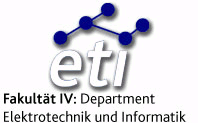Vorlesung Nanotechnologie
Die Vorlesung Nanotechnologie findet im WS statt.
Aktuelle Klausurtermine
| Halbleiterelektronik I | 20.02.2019 | 9 - 11 Uhr | H-C 3303 |
| Halbleiterelektronik II | 11.02.2019 | 9 - 11 Uhr | H-C 3303 |
| Mikroelektronik I | 22.02.2019 | 9 - 11 Uhr | H-C 3309 |
| Mikroelektronik II | 12.02.2019 | 9 - 11 Uhr | H-C 3309 |
| Halbleiter- und Schaltungstechnik | 25.02.2019 |
8 - 11 Uhr |
H-C 3309 |
| Nanotechnologie (ETI) | 01.03.2019 |
9-11 Uhr |
H-C 6321 |
| Nanotechnology (Nanoscience MSc) | 06.02.2019 |
14-16 Uhr |
ENC-D 114 |
| Nanotechnology (Nanoscience MSc) | 27.03.2019 |
13-15 Uhr |
ENC-D 114 |
| Nanoelectronic Dev. (Nanoscience MSc) | 29.03.2019 |
13-15 Uhr |
H-E 308 |


